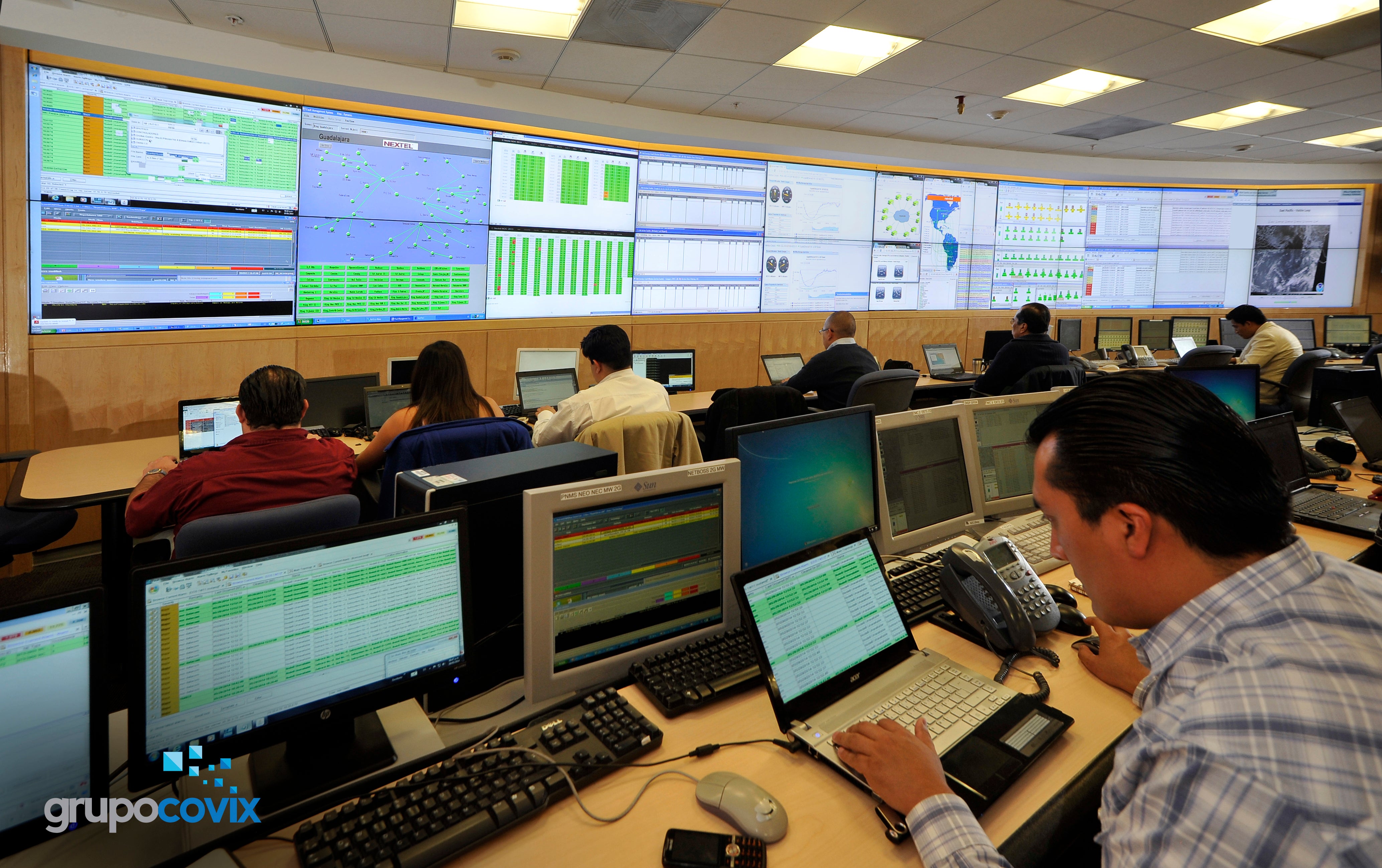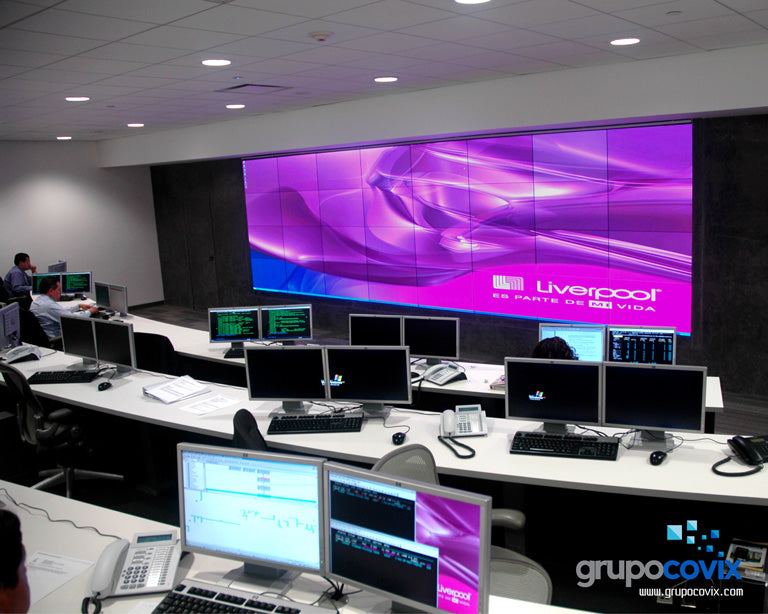Control Rooms
The Control Rooms are spaces where a series of operators check data and videos to react immediately to an alarm, emergency or event, using information systems to speed up their interpretation.
With more than 150 Control Rooms located in Mexico, Central and South America,
Grupo Covix has become the main provider of these solutions in our country.
Each Control Room has at least one Videowall displaying high definition video signals and information feeds that match the user’s specific requirements. This Video wall can be made of LED, LCD or PDP technology video cubes or flat panel displays with the least possible separation from each other. Besides displaying information, a collaboration system may be integrated with specialized software that is capable of sending and receiving video and audio data between different boardrooms, control rooms or videowalls. This way, the operations chief in a Control Room can send signals and data to the War Room, or to remote sites located in other buildings or cities, allowing them to react quickly and efficiently upon diverse incidents or security breaches. All of this with the right compression and encryption that ensure the data’s safety. The information display, hand in hand with the collaboration, are elements that will impact the operation and functionality of the system.
A Security Control Room is a Command, Control, Communication and Computer system, also called C4. These control rooms operate at three levels: municipal, state and federal, and operate 24/7 under strict rules and procedures that keep their response time to a minimum. To achieve this, high specs teams are provided - both Audiovisual and Physical security, backed up by a specialized technical team, always ready to provide the required maintenance.


C2´s, C4´s, C5´s
Security Control Rooms are Command, Control, Communications and Computer Systems, also called C4´s. These can operate on three levels: local, state and federal levels, and they remain in operation 24/7, under strict rules and procedures that lead them to minimize their emergency response times. To achieve this we provide high specification equipment, such as audiovisual and Physical Security, supported by a specialized technical area always ready to provide the required maintenance.
Each Control Room has at least one Videowall displaying high definition video signals and information feeds that match the user’s specific requirements. This Video wall can be made of LED, LCD or PDP technology video cubes or flat panel displays with the least possible separation from each other. Besides displaying information, a collaboration system may be integrated, with specialized software that is capable of sending and receiving video and audio data between different boardrooms, control rooms or videowalls. This way, the operations chief in a Control Room can send signals and data to the War Room, or to remote sites located in other buildings or cities, allowing them to react quickly and efficiently upon diverse incidents or security breaches. All of this with the right compression and encryption that ensure the data’s safety. The information display, hand in hand with the collaboration, are elements that will impact the operation and functionality of the Center.
Indoor and outdoor cameras, PTZ´s or fixed, analog or digital and DVRs with different capacities, are integral to our CCTV solutions. The Access Control is another core component for Physical Security solutions. The biometric readers, among other technologies, allow access safeguarding in private spaces.
NOC
What is a NOC?
Named NOC (Network Operation Center), these are centers used to monitor networks.
Created to address problems in network systems, telecommunications and satellite infrastructure.
These Centers have infrastructure and technology equipment for security information systems such as: Videowalls, Access Control, Security Equipment, Data Encryption, Power Backup Systems, Fire Protection Systems, CCTV and Video Surveillance Systems, Networking Equipment, etc., and technological equipment in general that will ensure the proper functioning of the systems as they handle highly relevant information.
SOC
What is a SOC?
(Security Operation Center) used for Physical Security Monitoring. Created to protect the most important elements of a public or private institution, information and its people, with the main objective of monitoring security systems to keep them away from unnecessary threats or risks.
Designed to operate 24 hours a day, the work centers are designed to ensure the safety of their end users. SOCs are usually accompanied by specialized software for monitoring physical security systems, also called MISP (Physical Security Information Management). This software is often the cornerstone for monitoring failures in the CSS Monitoring Center.
The SOCs have infrastructure and technology equipment for the security of information systems such as: Videowalls, Access Control, Security Equipment, Data Encryption, Power Backup Systems, Fire Protection Systems, CCTV and Video Surveillance Systems, Networking Equipment, etc., and technological equipment in general that will ensure the proper functioning of the systems as they handle highly relevant information.
SCADA
SCADA, Supervisory Control And Data Acquisition, is a concept used in computer software to control and monitor industrial processes remotely. Visually SCADA displays images with hundreds of colored lines connecting different modules or components, usually on a black background. The Energy Sector, specifically CFE and PEMEX in our country, make use of SCADA software to supervise and monitor their installations.
High resolutions are required to monitor all the information SCADA displays. Colored lines that splice and cross to connect different components remain static for long periods of time, which could cause images to "burn" or "mark" on the screens. This phenomenon is known as burn in, image sticking, or temporary image retention (TIR), and occurs most commonly on plasma screens, where it is appropriate to say that phosphorus burns. In LCD screens (even if they have LED backlighting), the phenomenon of image retention occurs, an effect that is counteracted by turning off the screens a few hours a day. The most appropriate way to eliminate this retention effect on an LCD screen is to use screens with external electronics, i.e. to remove the power supplies and digital video inputs from the screen chassis, mounting them in a rack located in a site with controlled conditions.
Throughout its history, Grupo Covix has installed dozens of SCADA Monitoring Centers. It did so in the '90s with rear-projection technology, and pioneered plasma, LCD, LED video hubs and DirectView LED technology, which represents the latest technology for this application and which completely avoids any image retention.
Call Centers
The Call Centers or CAT´s (Call Centers) are used as call centers for outbound or inbound calls in order to serve customers (external or internal), end users of any equipment or service, associated companies, business partners, etc., where they usually work 24 hours a day, 365 days a year.
Currently, there are different types of Call Centers where various concerns or services are attended to, such as: cardholder service, order taking or follow-up (CEDIS), reports and claims attention (Insurance), personalized Assistance Services, attention and reception of emergency calls, reception of complaints or doubts, reception of mails, text messages (SMS), instant messaging (whatsapp), among others.
These Centers are equipped with different equipment, Visualization and Collaboration Systems such as 24/7 screens, videowalls, 24/7 monitors, audio and microphones, A/V accessories, interior design and furniture, etc.
With us you can find the best components to equip and attend a Call Center or Attention Center.
UPS / No break
¿Qué es un UPS?
Un UPS (Uninterruptible Power Supply), o Sistema de Alimentación Ininterrumpida, es un dispositivo que proporciona energía de respaldo a equipos electrónicos en caso de una interrupción del suministro de energía eléctrica. Estos equipos también son conocidos como reguladores o No break para uso profesional. Su función principal es garantizar que los dispositivos conectados sigan funcionando sin apagarse abruptamente durante un corte de energía, evitando la pérdida de datos o daños en el hardware.
Los componentes principales de un UPS incluyen:
- Batería: Almacena la energía que se utiliza cuando hay una interrupción en la electricidad.
- Inversor: Convierte la energía almacenada en corriente continua (DC) en corriente alterna (AC), que es la utilizada por la mayoría de los dispositivos.
- Regulador de voltaje: Protege contra picos o caídas de tensión, estabilizando el suministro de energía.
Los UPS son comúnmente utilizados para proteger servidores, equipos de red, ordenadores y dispositivos electrónicos sensibles en Salas de Crisis, Centros de Monitoreo, Centros de datos y otros entornos críticos.






















